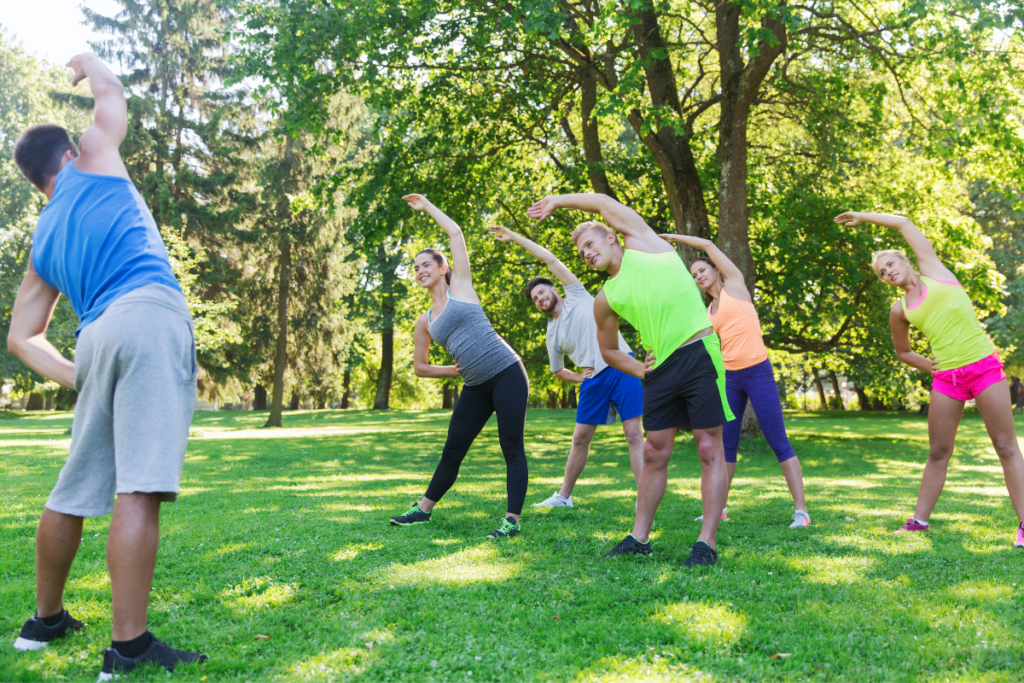Making Outdoor Fitness Work
Whether they used parks or parking lots, these fitpreneurs adapted and thrived.

As the weather warms, people want to go outside and soak up the sun as they walk or bike around town. Many also want to attend classes! While outdoor fitness has always been appealing—and last year many studios and gyms were forced to move programs outside to accommodate lockdowns—businesses are realizing that, with summer approaching, this is the ideal way to keep patrons engaged. After all, many people remain wary of enclosed spaces.
No matter how “open” your region is, outdoor workouts are sure to be a hit this summer, so we gathered some tips from those who have already adapted successfully to an open-air approach.
Prepare to Beat the Heat
“There’s no such thing as bad weather, just bad clothing choices,” says Jeff Watters of Watters Performance and M1 Fight Club in the Detroit area; he’s been teaching outdoors year-round since 1995. Using weather-appropriate gear is imperative, but it can be easier to dress for the cold than the heat, and you may have to make extra adjustments as the mercury rises. For example, Watters preaches the importance of hydration and sets a timer that reminds attendees to sip water every 15 minutes.
Lisa Herrington, ACSM-certified personal trainer and founder of FIT House Davis, has already moved to outdoor classes. In Davis, California, temperatures can climb into the 100s during the summer, so Herrington purchased a shade structure to cover the studio parking lot. She also provides cooling towels.
Make sure you take frequent breaks, adds personal trainer and fitness instructor Sarah Turino, CEO and founder of The Whole Woman Wellness Formula in St. Paul, Minnesota. “Heart rate climbs higher and faster during warm-weather workouts, so you’ll want to take more breaks and consider stepping your workout back, depending on people’s responses,” she says. “Check in with your attendees and notice if they’re struggling.”
When the weather is truly punishing, Herrington recommends having a virtual backup plan, for everyone’s safety.
See also: Hot Training for Outdoor Enthusiasts
Get Creative With Your Space for Outdoor Fitness
From past outdoor gigs, Watters knows how to use what he has, such as parking garages, hills and trails. He takes his classes to a high-school track, where participants use bleachers for running and girders for pullups. Or he’ll utilize parking decks for stair intervals, ramp sprints and pushups. Parking curbs become plyo boxes for jumps, and during forest hikes people carry large rocks. “The only equipment we ever use is our bodies,” Watters says. “Whatever is available to us is what we use.” He adds that creativity can make the workout feel more like playing than conditioning.
Herrington agrees that parks, open fields, beaches and empty parking lots are all great venues for outdoor workouts: “Benches can be used for pushups, triceps dips and step-ups; the beach provides extra resistance training when exercises are performed in the sand; and the grass is a great spot to perfect a plank.”
Safety should always come first, says Turino, who teaches neighborhood boot camps in various locations. “Scope out the site ahead of time so you can warn people about hazards such as divots in the grass or uneven sidewalks, and clean the area of anything like garbage or pet waste that could get in the way.” She also recommends planning your public workouts for quieter times, to accommodate attendees who feel self-conscious around lots of people. Finally, she advises instructors to have a substantial first-aid kit available at the site; she has used hers more than once.
See also: No-Equipment Outdoor Workouts
Consider the Format
While running around town is fun, many clients prefer a gym-based workout, which can still take place outdoors with a little advance planning. Herrington pivoted quickly, and a year into the pandemic she has found that clients prefer the in-person outdoor experience over livestreamed sessions. “Virtual classes may be convenient, but nothing beats the energy, synergy and connectivity of an in-person workout, and I love seeing the many (masked) faces in our outdoor classes.”
Organizing these sessions adds a little extra work, of course, but it’s worth it. While some classes, such as boot camp and yoga, transition almost seamlessly, formats like cycling take more effort. Herrington’s staff move the bikes out before every class and return them to the studio afterward; it requires two people to lift the bikes. “While it adds 30 extra minutes to setup and takedown, it’s worth it for all the riders who show up to support each other and us,” she says.
For other classes offered by FIT House Davis, clients bring their own equipment, such as mats, weights, bands and jump ropes—all of which Herrington sold to clients in a handy studio-branded drawstring bag at the beginning of the pandemic. While the outdoor capacity is half what the gym could accommodate previously, Herrington acknowledges how grateful she and her staff are to have found ways to keep connecting with clients outside of the studio walls.
Embrace the Greatness of Outdoor Fitness
Zac Walker, co-founder of CAZ Training Club in Newport Beach, California, moved his entire gym to the third floor of the parking garage so his team could operate outside. Besides keeping team members and clients safe from COVID-19, this has helped them build an even stronger community. “There’s nowhere for staff to hide, so [they] socialize with the customers more, safely of course, and form a more meaningful connection,” he says.
Additionally, it’s common knowledge that the outdoors can do wonders to boost mental well-being. “Clients really enjoy being outside and getting fresh air, and there is nothing like a cooldown with the birds chirping and the wind in the trees,” Watters says. “It helps reconnect people with nature at a time when we haven’t been able to get outside as much.” He also finds that in a natural setting there is more camaraderie and people are more likely to bond and support one another, even while maintaining a safe distance.
“I often feel that exercise is second to the primary reason that clients continue to show up—and that’s to be there for each other,” says Herrington. “Clients appreciate the ability to spread out and soak in the vitamin D.”
See also: Safety Tips for Outdoor Group Exercise
Keep a Positive Attitude
Finally, remember that everyone is going through changes. By continuing to offer great workouts that promote a little normalcy and routine for your clients when most of their habits have been disrupted, you give people a wonderful gift.
As Walker acknowledges, moving a fitness space into a parking structure comes with a lot of change for both customers and staff. “It’s important to say thank you to both customers and staff who are enduring these changes with you,” he notes.
The great news is that outdoor fitness offers a host of benefits—for your clients and your busines. By embracing a novel way of exercising safely, clients may have discovered a new favorite workout. Outdoor fitness could prove to be one of the silver linings we’ve been searching for over the past year—a good “new normal” activity that might endure.
Cathie Ericson
Cathie Ericson is a freelance writer who specializes in health/fitness and business topics. She loves group fitness classes, especially now, especially outdoors, even in the variable Oregon weather. Find her @cathieericson.





